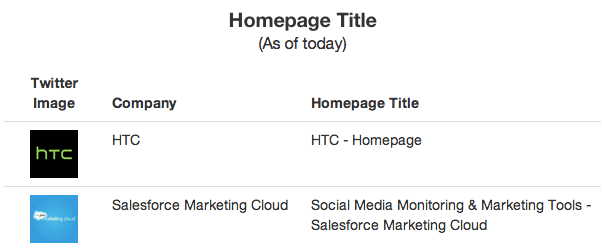Title tags should be the cornerstone of your SEO strategy. They communicate with two equally important audiences – the search engines and your prospects.
The keywords in your tag are used in search algorithms to factor where your page will rank among the returned results. Then, that same phrase will appear as the first line of your SERP listing – the first copy potential prospects read as they scan their search results and decide which is worthy of further investigation.
Are your title tags working hard enough?
To help you decide, I’ve pulled a couple of examples of homepage title tags – one that’s optimized to make the most of the 70 character limit and another that isn’t. Take a minute to decide where your homepage title tag falls on the spectrum:
The Contenders:
And Their Search Results:

There is a broad spectrum of title tag effectiveness. Make sure you are headed toward the strong end.
Clearly, HTC hasn’t spent any time on their SEO strategy, but the effort Salesforce took to craft their title tag paid off. Not only are they making good use of their keywords, they’ve crafted phrasing that engages prospects and invites them to click through. Could they have written a meta description that was less repetitive, more complimentary to the title tag? Yes…but that’s another blog post ;-).
Title Tags 101
So we’re all working from the same understanding of what makes a good title tag, I’ve summarized the best practices recommended by SEOmoz.
- No more than 70 characters
- List keywords first, save the company name for the end
- Prioritize keywords. Those at the start have the most impact.
- Write for humans and search engines. Tags that read as sentences will be more compelling to your audience.
I also wanted to share the cumulative wisdom revealed in SEOmoz’ survey of SEO Thought Leaders ,“the title tag is the most important place to use keywords to achieve high rankings.” The companies in my top five ranking not only got the memo, they did an outstanding job of re-crafting their title tags.
Introducing the Top Five Best Title Tag Upgrades
To compile the list, I reviewed the thousands of companies Rival IQ tracks on behalf of our customers, selecting the best title tag changes made in the last 60-90 days. To be considered, a company had to improve on a title tag that was more than just the company name. Yes, this was a subjective exercise, based on my opinion of improvement in keywords usage and expect overall impact on SEO strategy. Please use the comments section if you disagree, have feedback or have other great examples.
IN FIFTH PLACE . . . KOGNITIO
Key Improvements:
- According to SEO best practices, moved the branded name to the end
- Increased customer readability by moving to a sentence format
- Tuned their keywords, moving the more specific “Memory Analytics” to the front position and swapping “Business Analytics” for “Cloud”.
Comments:
Strong application of SEO best practices along with keyword tuning should deliver for Kognito. I’m trusting Kognito that “Business Analytics” wasn’t performing for them – it was likely too broad a term.
IN FOURTH PLACE . . . EPINIONS
Key Improvements:
- Clear upgrade from “Reviews” to two search friendly keyword bundles “Product Reviews” and “Trusted Ratings”
- Continued effective use of “…from Epinions” to help engage prospects in their search results
Comments:
Moving from the generic to the specific with two powerful keyword bundles should deliver strong SEO results for Epinions.
IN THIRD PLACE. . . LEADPILE

A move to stronger keywords in terms of SEO strength for LeadPile. A question about too many “qualifieds”
Key Improvements:
- Good shift from the inspirational, but ineffective as keywords, “Buyers, Meet Sellers. Meet Profits.” to three clear keyword bundles that read nicely for prospects.
Comments:
- Moving the brand name to the end of the tag will give the keywords more impact.
Call Out to Optimizers:
I’d love to hear the experts’ opinion on the impact of using “Qualified” three times in this tag. Is there a chance it gets highlighted as keyword stuffing? Or, because “qualified” is used in logical keyword groups, there’s increased likelihood of ranking on the term?
IN SECOND PLACE . . . 15FIVE
Key Improvements:
- Eliminated the double use of their brand name
- Tuned their keywords. Moved from the reasonably strong “Employee Feedback” (880 Monthly Global Google Searches on Exact Phrase) to the more powerful “Employee Engagement” (18,100 exact phrase searches/mo)
- Added a second keyword group “Team Communication & Reporting” which also has strong number of monthly exact phrase searches—1,000/month.
Comments:
- These were strong changes and I expect them to deliver improved SEO performance for 15Five.
- To increase the impact of the “Employee Engagement” keyword bundle, they need to move the brand name to the end of the tag.
AND THE WINNER IS . . . APPTIO
Key Improvements:
- Left the keyword ambiguous “Innovation is your business” behind and moved to two keyword groups “Information Technology Service Costing” and “IT Benchmarking”
- Successfully utilized both “Information Technology” and “IT” in the tag to capture both keywords.
- Applied the best practices for human readability and brand name placement.
Comments:
Excellent keyword upgrade and application of best practices. I expect this to perform well for Apptio.
Key Takeaways.
You can’t set and forget your title tags – they need to be reviewed regularly to ensure you’re leveraging best practices and popular search terms. Understanding how your competitors are optimizing their title tags over time – something my company, Rival IQ makes easy – will give you insight on how to fine tune your tags and adjust your overall SEO strategy.





